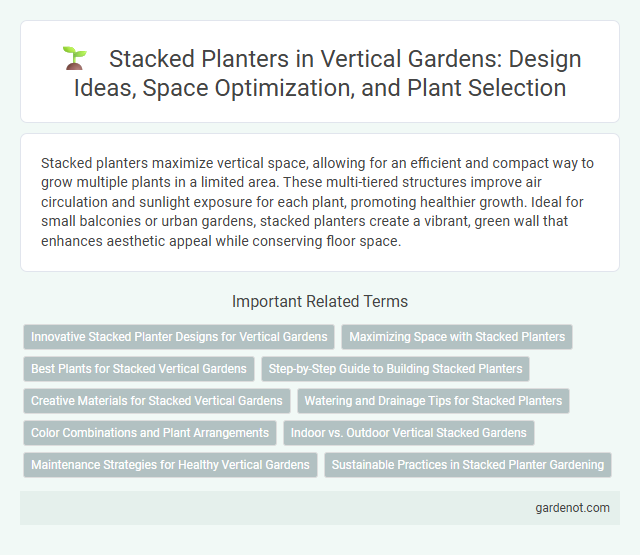Stacked planters maximize vertical space, allowing for an efficient and compact way to grow multiple plants in a limited area. These multi-tiered structures improve air circulation and sunlight exposure for each plant, promoting healthier growth. Ideal for small balconies or urban gardens, stacked planters create a vibrant, green wall that enhances aesthetic appeal while conserving floor space.
Innovative Stacked Planter Designs for Vertical Gardens
Innovative stacked planter designs for vertical gardens maximize space efficiency by layering multiple plant containers vertically, allowing a diverse range of plants to thrive in compact areas. These designs feature modular components made from sustainable materials such as recycled plastics or bamboo, enhancing durability and environmental friendliness. Integrated irrigation systems and customizable configurations further promote healthy plant growth and aesthetic appeal in urban gardening settings.
Maximizing Space with Stacked Planters
Stacked planters maximize space efficiently by utilizing vertical layers to cultivate multiple plants in a compact footprint, ideal for small balconies or urban gardens. These planters promote better air circulation and sunlight exposure for each plant, enhancing growth and yield. Incorporating modular designs with sturdy materials ensures stability and ease of maintenance in vertical gardening systems.
Best Plants for Stacked Vertical Gardens
Succulents such as Echeveria and Sedum thrive in stacked vertical gardens due to their low water needs and compact growth. Herbs like thyme, oregano, and chives are ideal for these planters, providing both greenery and culinary benefits while adapting well to vertical spaces. Ferns and trailing plants like string of pearls enhance visual interest and maximize the use of layered planting in stacked vertical arrangements.
Step-by-Step Guide to Building Stacked Planters
Building stacked planters involves selecting durable, weather-resistant materials like cedar wood or recycled plastic to ensure longevity and stability. Start by assembling individual planter boxes, then securely stack and fasten them using brackets or screws to create a vertical structure that supports healthy plant growth. Incorporate proper drainage holes and fill each level with high-quality soil, planting a mix of herbs, succulents, or flowers to maximize space and create an attractive vertical garden.
Creative Materials for Stacked Vertical Gardens
Stacked planters for vertical gardens utilize innovative materials such as recycled wood, eco-friendly plastics, and metal frames to maximize durability and sustainability. Modular designs often incorporate lightweight composites and fabric pockets, enhancing water drainage and root aeration for healthier plants. These creative materials enable customizable configurations, making stacked vertical gardens adaptable for both indoor and outdoor spaces.
Watering and Drainage Tips for Stacked Planters
Stacked planters require efficient watering techniques to prevent waterlogging while ensuring each tier receives adequate moisture. Incorporate drainage holes at every level and use well-draining soil mixes to facilitate excess water flow. Elevating the planter on a tray or saucer helps collect runoff, preventing damage to surfaces and promoting healthier root systems.
Color Combinations and Plant Arrangements
Stacked planters offer a vibrant canvas for color combinations, blending lush greens with blooming reds, yellows, and purples to create eye-catching vertical gardens. Strategic plant arrangements emphasize contrast and harmony by pairing foliage textures and hues, enhancing both aesthetics and plant health. Incorporating trailing vines alongside compact succulents maximizes depth and visual interest in these space-efficient garden designs.
Indoor vs. Outdoor Vertical Stacked Gardens
Stacked planters optimize space in vertical gardens by allowing multiple plants to grow in a compact, tiered structure. Indoor vertical stacked gardens benefit from controlled light and temperature, promoting year-round growth for herbs and small houseplants, while outdoor versions withstand varying weather conditions and support larger plant varieties. Selecting weather-resistant materials like cedar or recycled plastic enhances outdoor garden durability, contrasting with lighter, decorative options ideal for indoor use.
Maintenance Strategies for Healthy Vertical Gardens
Stacked planters in vertical gardens require regular watering schedules and well-draining soil to prevent root rot and promote healthy growth. Pruning dead leaves and rotating plants encourage even sunlight exposure and air circulation, reducing pest infestation. Incorporating slow-release fertilizers and monitoring moisture levels optimize nutrient uptake for thriving, vibrant vegetation.
Sustainable Practices in Stacked Planter Gardening
Stacked planter gardening promotes sustainable practices by maximizing green space in urban environments and reducing the need for extensive soil and water usage. Utilizing recycled or biodegradable materials for planters enhances environmental responsibility while encouraging efficient water management through drip irrigation systems. These practices support biodiversity, improve air quality, and contribute to energy savings by insulating buildings.
Stacked planter Infographic

 gardenot.com
gardenot.com